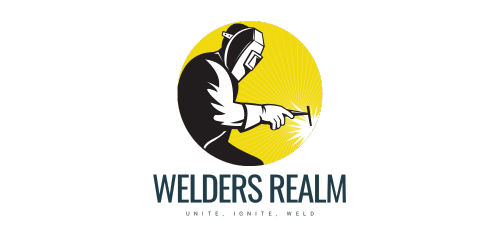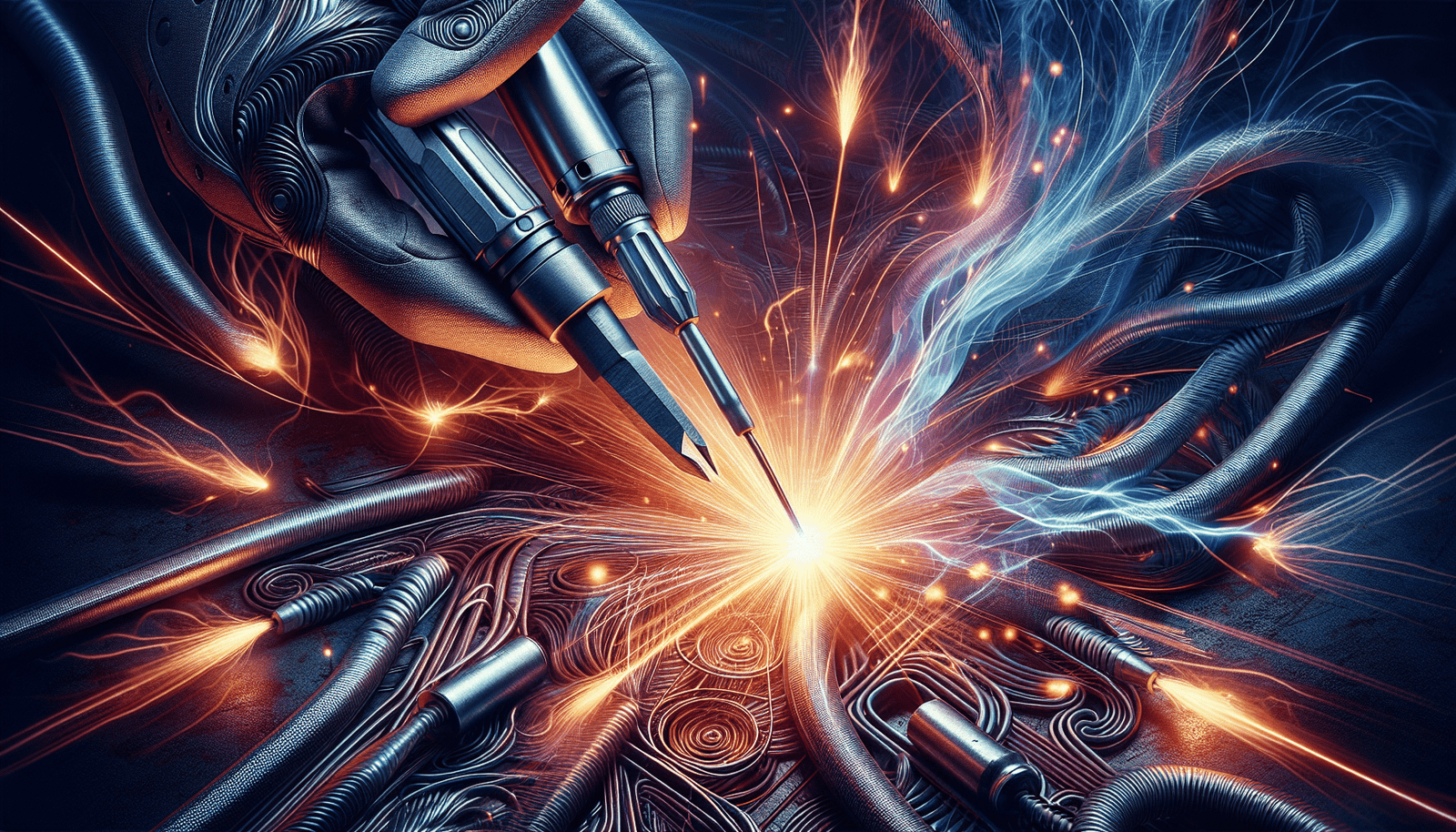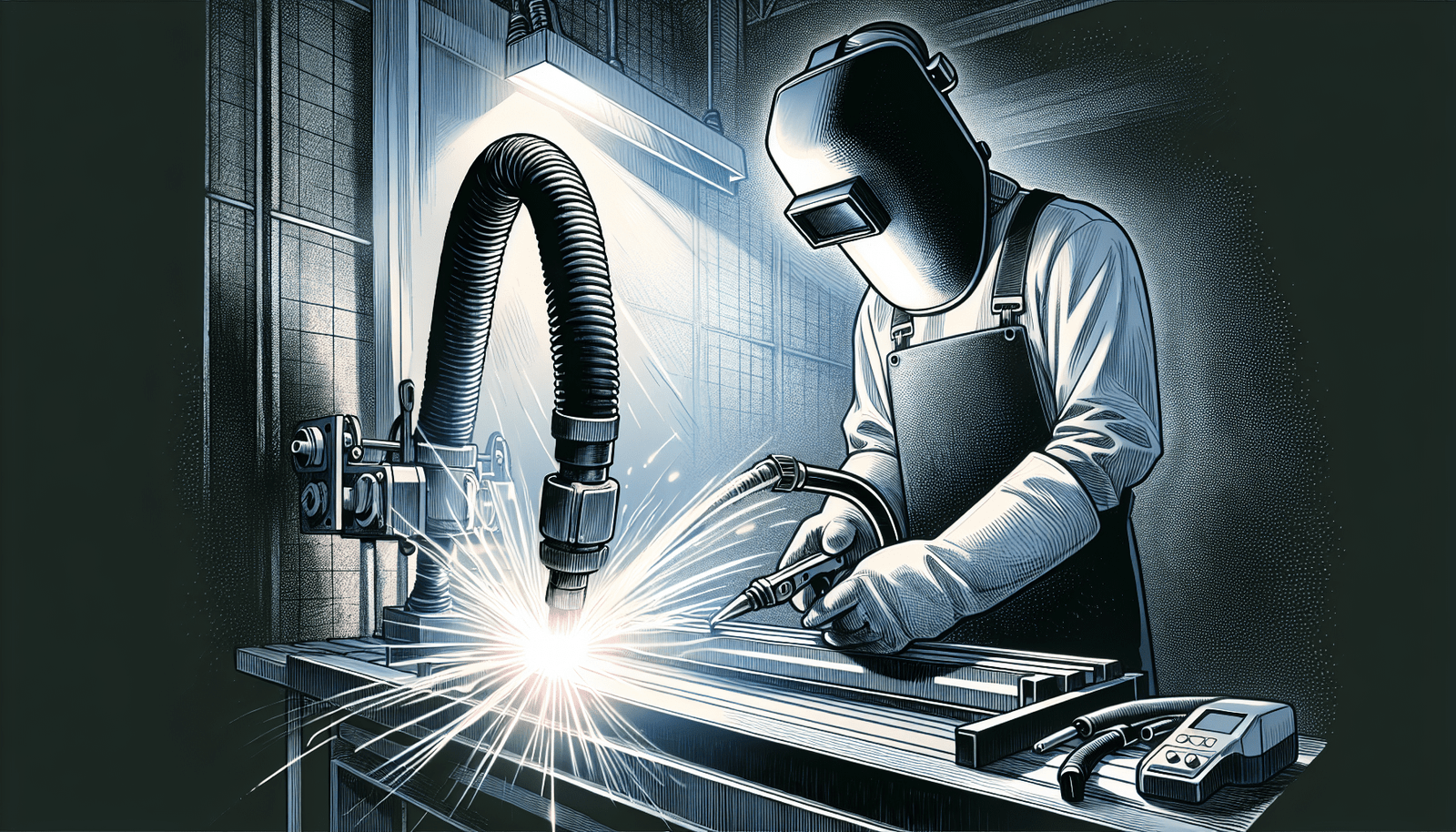If you’ve ever been intrigued by the art of welding and have a burning desire to try your hand at it, then you’ve come to the right place. In this beginner’s guide to aluminum welding, we’ll break down the basics and answer all the questions you may have about this fascinating craft. Whether you’re a welding guru looking to expand your skills or simply someone searching for reliable welding product reviews, we’ve got you covered. From understanding the materials and equipment needed to mastering the techniques, we’ll provide you with all the information you need to get started. So, let’s dive in and explore the world of aluminum welding together!
Understanding Aluminum Welding
What is aluminum welding?
Aluminum welding is the process of joining two or more pieces of aluminum together using heat and a filler material. This process allows for the creation of strong, durable, and structurally sound welds. Aluminum welding is commonly used in various industries, including automotive, aerospace, and construction, due to the lightweight and corrosion-resistant properties of aluminum.
Important characteristics of aluminum
Aluminum has several important characteristics that differentiate it from other metals. Firstly, aluminum has a low melting point, which means it requires less heat to weld compared to other metals. Additionally, aluminum has a high thermal conductivity, meaning it dissipates heat quickly. This can pose challenges during the welding process as it requires precise control of heat.
Furthermore, aluminum forms an oxide layer when exposed to air, which can impede the welding process. It is important to remove this oxide layer through proper cleaning techniques before welding to ensure a successful weld.
The structural differences between aluminum and other metals
Aluminum has different structural properties compared to other metals, such as steel. Aluminum has a lower tensile strength, meaning it is not as strong as steel. However, aluminum is much lighter, making it an ideal choice for applications where weight is a concern.
Additionally, aluminum has a higher thermal expansion coefficient compared to steel. This means that aluminum will expand and contract more with temperature changes, which can affect the integrity of the weld. Proper heat control and temperature management are crucial in aluminum welding to minimize the risk of distortion or cracking.
Safety Measures in Aluminum Welding
Importance of safety in welding
Safety is of paramount importance in any welding process, including aluminum welding. Welding involves working with high temperatures, hazardous fumes, and potential electrical hazards. It is crucial to prioritize safety to prevent accidents, injuries, and long-term health effects.
Safety equipment necessary for aluminum welding
When engaging in aluminum welding, several safety equipment items are essential. These include:
Welding helmet: A welding helmet with a darkened lens is necessary to protect your eyes from the intense light emitted during the welding process.
Welding gloves: Heat-resistant gloves are required to protect your hands from burns and sparks.
Welding apron: A durable apron made of flame-resistant material helps protect your body from sparks, hot metal, and UV radiation.
Protective clothing: Wear long-sleeved shirts and long pants made of flame-resistant material to shield your skin from heat and sparks.
Respirator: A respirator is necessary to protect against fumes and airborne particles that are generated during welding.
Ventilation: Ensure proper ventilation in your workspace to minimize exposure to welding fumes and maintain air quality.
Safety practices to maintain during aluminum welding
In addition to utilizing the appropriate safety equipment, it is vital to follow certain safety practices during aluminum welding:
Fire prevention: Keep a fire extinguisher nearby and clear the work area of any flammable materials.
Proper grounding: Ensure that your welding equipment is properly grounded to prevent electrical shocks.
Eye protection: Always wear safety glasses with side shields underneath your welding helmet to protect your eyes from flying debris.
Welding in a well-ventilated area: Proper ventilation helps to reduce fume inhalation and maintain a safe working environment.
Stay hydrated: Welding can be physically demanding work, so it is important to stay hydrated to prevent fatigue or dizziness.
Essential Tools for Aluminum Welding
Choosing the right welding machine
When it comes to aluminum welding, selecting the right welding machine is crucial. There are various types of welding machines available, such as TIG (Tungsten Inert Gas) welders and MIG (Metal Inert Gas) welders. TIG welders are commonly used for aluminum welding due to their precise control and ability to create strong, high-quality welds.
When choosing a TIG welder for aluminum welding, consider factors such as amperage range, duty cycle, and AC/DC capabilities. It is essential to choose a welder that suits your specific requirements and budget.
Selecting appropriate shielding gas
Shielding gas is a critical component in aluminum welding as it helps protect the weld pool from atmospheric contamination. Argon is the most commonly used shielding gas for aluminum welding due to its inert properties and ability to produce a stable arc.
Ensure that you have the appropriate gas supply and regulator for your welding machine. It is important to use high-quality shielding gas to achieve clean, strong welds.
Understanding filler metal selection
Filler metal is used to fill the gaps between the aluminum pieces being welded together. It is essential to select the appropriate filler metal for aluminum welding to ensure proper fusion and avoid issues such as cracking or porosity.
There are various types of aluminum filler metals available, such as ER4043 and ER5356. The choice of filler metal depends on factors such as the alloy being welded, the desired strength of the weld, and the welding process being used.
Consult the manufacturer’s recommendations or seek advice from welding experts to determine the most suitable filler metal for your specific application.
Usage of cleaning brushes and wire brushes
Before welding aluminum, proper cleaning is crucial to remove any contaminants, such as dirt, oil, or oxide layers, from the surface. Cleaning brushes and wire brushes help in the cleaning process by removing these impurities, ensuring a clean surface for welding.
Use stainless steel wire brushes or dedicated aluminum cleaning brushes to avoid cross-contamination with other metals. Clean the surface thoroughly, paying attention to corners and tight spaces, before proceeding with the welding process.
The Welding Process
Preparation of aluminum prior to welding
Before starting the welding process, proper preparation of the aluminum is essential. This includes:
Cleaning: As mentioned earlier, clean the aluminum surface using cleaning brushes and remove any contaminants that may hinder the welding process.
Fit-up: Ensure that the pieces to be welded are properly aligned and secured in place before starting the welding process. This helps in achieving accurate and strong welds.
Joint design: Depending on the application and desired strength, select an appropriate joint design, such as butt joint, lap joint, or T-joint.
Tacking: Use tack welds to temporarily hold the pieces in place. This helps prevent misalignment during the welding process.
Understanding the welding arc
The welding arc is the controlled electrical discharge that creates the heat necessary for welding. In aluminum welding, it is important to understand the characteristics of the welding arc, as aluminum has a higher thermal conductivity compared to other metals.
Maintain a consistent arc length and proper torch angle to ensure a stable arc. A stable arc helps in achieving good penetration and allows for proper control of heat input.
Correct technique for electrode motion
The technique for electrode motion, also known as torch movement, plays a crucial role in aluminum welding. A push technique is commonly used, where the torch is moved away from the direction of the weld. This helps in maintaining proper heat distribution and reduces the risk of overheating.
Ensure a steady and continuous motion, maintaining a consistent travel speed. Practice and experience are key in mastering the correct technique for electrode motion in aluminum welding.
Understanding the role of heat control and temperature management
Heat control and temperature management are critical in aluminum welding to prevent distortion, cracking, or weakening of the weld. Proper heat control involves striking a balance between providing enough heat to achieve fusion and avoiding overheating.
Different aluminum alloys require different heat inputs, so it is important to understand the specific requirements of the aluminum being welded. Adjust the amperage and travel speed accordingly to maintain the appropriate heat level throughout the welding process.
Types of Aluminum Welding
Gas Tungsten Arc Welding (GTAW)
Gas Tungsten Arc Welding, also known as TIG welding, is commonly used for aluminum welding. It is a versatile welding process that provides excellent control and produces high-quality welds. GTAW involves the use of a non-consumable tungsten electrode, a shielding gas (such as argon), and a filler metal.
TIG welding can be performed on various thicknesses of aluminum and allows for precise control over the welding parameters. It is suitable for both thin and thick aluminum sections, making it a preferred choice in many applications.
Gas Metal Arc Welding (GMAW)
Gas Metal Arc Welding, also known as MIG welding, is another commonly used welding process for aluminum. It is a semi-automatic process that involves the use of a consumable electrode wire, a shielding gas (such as argon), and a power source.
MIG welding offers high productivity and is often used in applications where speed is a priority. It is suitable for thicker aluminum sections and can provide good penetration and fusion. However, MIG welding may not provide the same level of precision and control as TIG welding.
Shielded Metal Arc Welding (SMAW)
Shielded Metal Arc Welding, also known as stick welding, is less commonly used for aluminum welding. It involves the use of a coated electrode, known as a stick electrode, and a power source.
SMAW can be challenging for aluminum welding due to its lower heat input and lack of precision control. However, it can be suitable for certain applications, such as repair work or welding thicker sections of aluminum.
Welding Defects and Solutions
Common defects in aluminum welding
Aluminum welding can be prone to various defects if not performed properly. Some common defects in aluminum welding include:
Porosity: Small gas pockets within the weld, caused by improper shielding gas or inadequate cleaning.
Cracking: Cracks can occur due to excessive heat input, rapid cooling, or improper joint preparation.
Lack of fusion: Insufficient bonding between the base metal and the filler metal, caused by improper heat input or improper technique.
Burn-through: Excessive melting or penetration, resulting in holes or thinning of the base metal.
Troubleshooting defective welds
To address welding defects in aluminum, it is important to identify the root cause and take appropriate corrective measures. Here are some troubleshooting tips:
Porosity: Ensure proper cleaning, use high-quality shielding gas, and adjust the gas flow rate if needed.
Cracking: Control the heat input and cooling rate, preheat if necessary, and use appropriate joint preparation techniques.
Lack of fusion: Increase heat input, adjust travel speed, or change the welding technique to ensure proper bonding.
Burn-through: Reduce heat input, adjust travel speed, or use backing plates or heat sinks to control excessive melting.
Preventative measures against welding defects
Preventing welding defects in aluminum requires attention to detail and adherence to proper welding techniques. Some preventative measures include:
Proper cleaning: Thoroughly clean the aluminum surface to remove any contaminants that can lead to defects.
Adequate shielding gas: Use high-quality shielding gas and ensure the flow rate is appropriate for the specific welding process and application.
Control heat input: Maintain proper heat control and temperature management to prevent overheating or rapid cooling.
Joint preparation: Ensure proper fit-up, alignment, and joint design to promote strong fusion and minimize the risk of defects.
Post-Welding Procedures
Cleaning and inspection of the weld
After completing the welding process, it is important to clean and inspect the weld to ensure its quality and integrity. Here are some post-welding procedures to follow:
Remove slag and spatter: Clean the weld area to remove any slag or spatter using appropriate cleaning tools, such as wire brushes or chipping hammers.
Visual inspection: Inspect the weld visually to identify any surface irregularities, cracks, or signs of incomplete fusion.
Non-destructive testing: Depending on the application and requirements, consider performing non-destructive testing methods, such as ultrasonic testing or dye penetrant testing, to detect any hidden defects.
Post-weld cleaning: Clean the weld area again to remove any residual contaminants or cleaning agents. This helps maintain the appearance and cleanliness of the weld.
Understanding stress-relieving
Stress-relieving is a post-weld heat treatment process that helps reduce internal stresses in the weld and base metal. Aluminum weldments can experience residual stresses due to the thermal cycling during the welding process.
Heat treatment can help minimize the risk of distortion, cracking, or failure of the weld by relieving these residual stresses. The specific heat treatment parameters and procedures depend on the aluminum alloy and the welding process used.
Importance of weld finishing
Weld finishing is the final step in the aluminum welding process and involves smoothing and refining the appearance of the weld. While weld strength and integrity are the primary concerns, a good weld finish enhances the overall aesthetics of the final product.
Weld finishing techniques include grinding, sanding, and polishing the weld surface to remove any roughness, weld spatter, or visual imperfections. Additionally, applying appropriate surface treatments, such as anodizing or painting, can provide further protection and improve the appearance.
Training and Certification
Where to get trained for aluminum welding
To become proficient in aluminum welding, it is advisable to seek proper training from reputable institutions or vocational schools. Look for welding programs that offer specialized courses in aluminum welding, as they will provide the necessary knowledge and hands-on experience.
Some options for training include community colleges, trade schools, or welding certification programs offered by professional welding organizations.
Importance of welding certification
Obtaining welding certification is highly beneficial for aluminum welders. Certification provides recognition of your skills and knowledge in the field and can enhance your credibility as a professional welder. Many employers require welding certification as a prerequisite for employment.
Certification programs typically involve theoretical exams and practical welding tests to assess your proficiency in various welding techniques, including aluminum welding. Certification is available through organizations such as the American Welding Society (AWS) or the Canadian Welding Bureau (CWB).
Average cost and length of welding certification programs
The cost and length of welding certification programs can vary depending on the institution and the specific program. On average, a comprehensive welding certification program can range from a few weeks to several months in duration. The cost can range from a few hundred dollars to several thousand dollars, depending on the program’s length and curriculum.
Consider factors such as the reputation of the institution, the qualifications of the instructors, and the resources and facilities available before enrolling in a welding certification program.
Career Opportunities in Aluminum Welding
Job prospects for aluminum welders
Aluminum welding skills are in demand across various industries. Opportunities for aluminum welders can be found in sectors such as aerospace, automotive, marine, construction, and manufacturing.
Some potential job titles in aluminum welding include aluminum welder, TIG welder, fabricator, or welder-fitter. The specific job prospects for aluminum welders can vary depending on factors such as location, industry demand, and personal experience and qualifications.
Average pay for aluminum welders
The average pay for aluminum welders can vary depending on factors such as location, experience, certifications, and the specific industry. According to the U.S. Bureau of Labor Statistics, as of May 2020, the median annual wage for welders, cutters, solderers, and brazers was $44,190.
The pay scale for aluminum welders can range from entry-level positions with lower pay to more experienced positions with higher salaries. Acquiring additional certifications or specializing in high-demand industries can also lead to higher earning potential.
Continuing education for career advancement
Continuing education is crucial for career advancement and staying up-to-date with the latest advancements in aluminum welding techniques and technologies. Consider pursuing advanced welding courses, specialized certifications, or attending workshops and seminars to enhance your skills and knowledge.
Continuing education can open doors to higher-paying positions, managerial roles, or even entrepreneurship opportunities in the welding industry. Stay informed about industry trends, participate in professional networks, and continuously strive to expand your skill set to remain competitive in the job market.
Shop Welding Gear Online
Importance of quality gear
When it comes to aluminum welding, using high-quality welding gear is essential for safety, efficiency, and achieving optimal weld results. Investing in quality gear ensures durability, reliability, and better performance during the welding process.
Quality gear, such as welding helmets, gloves, and clothing, offers superior protection against sparks, heat, and other welding hazards. It also enhances comfort, allowing you to focus on the welding task at hand without distractions.
Recommended gear for aluminum welding
When shopping for aluminum welding gear, consider the following essential items:
Welding helmet: Look for a helmet with an auto-darkening lens, adjustable settings, and a comfortable headgear system.
Welding gloves: Choose heat-resistant gloves that provide dexterity and grip, while also protecting your hands from burns.
Welding apron: Select a flame-resistant apron that covers your body and provides adequate protection against sparks and hot metal.
Protective clothing: Invest in flame-resistant clothing, such as welding jackets or coveralls, to shield your body from heat and sparks.
Respirator: Opt for a respirator that meets the requirements for welding fumes and provides a comfortable fit for long periods of use.
Tips on purchasing welding gear online
When purchasing welding gear online, consider the following tips:
Read product reviews: Take the time to read reviews from other buyers to get a sense of the quality and performance of the gear.
Check for certifications: Look for gear that meets industry standards and carries relevant certifications for safety and performance.
Size and fit: Pay attention to size charts and recommendations to ensure the gear will fit properly and provide adequate protection.
Compare prices: Compare prices from different online retailers to ensure you are getting the best value for your money.
Warranty and return policy: Check the warranty and return policy of the online retailer to ensure you have recourse in case the gear does not meet your expectations.
Remember, investing in high-quality gear ensures not only your safety but also the quality and efficiency of your aluminum welding projects.
In conclusion, understanding aluminum welding is crucial for anyone interested in working with this versatile and widely used material. By familiarizing yourself with the characteristics of aluminum, practicing proper safety measures, and acquiring the essential tools and techniques, you can become a skilled and proficient aluminum welder. Whether you choose a career in aluminum welding or pursue it as a hobby, the opportunities and satisfaction that come with mastering this skill are endless. So, start your aluminum welding journey today and enjoy the rewarding experiences that await you in the world of metal fabrication.




